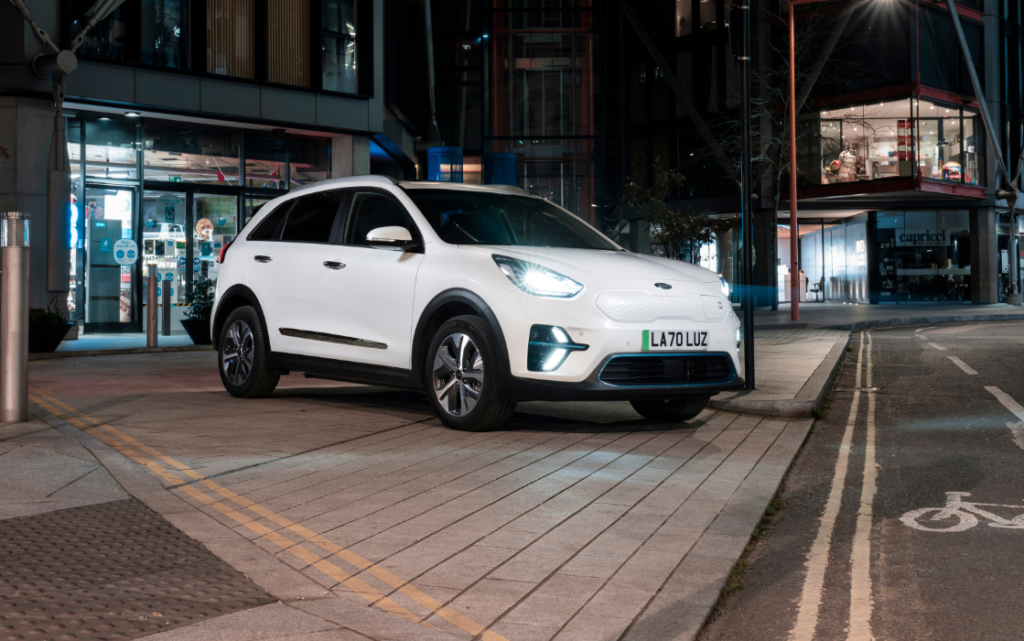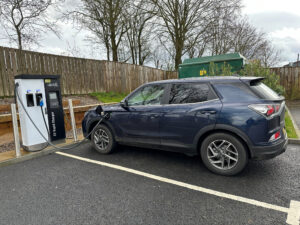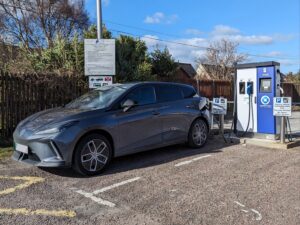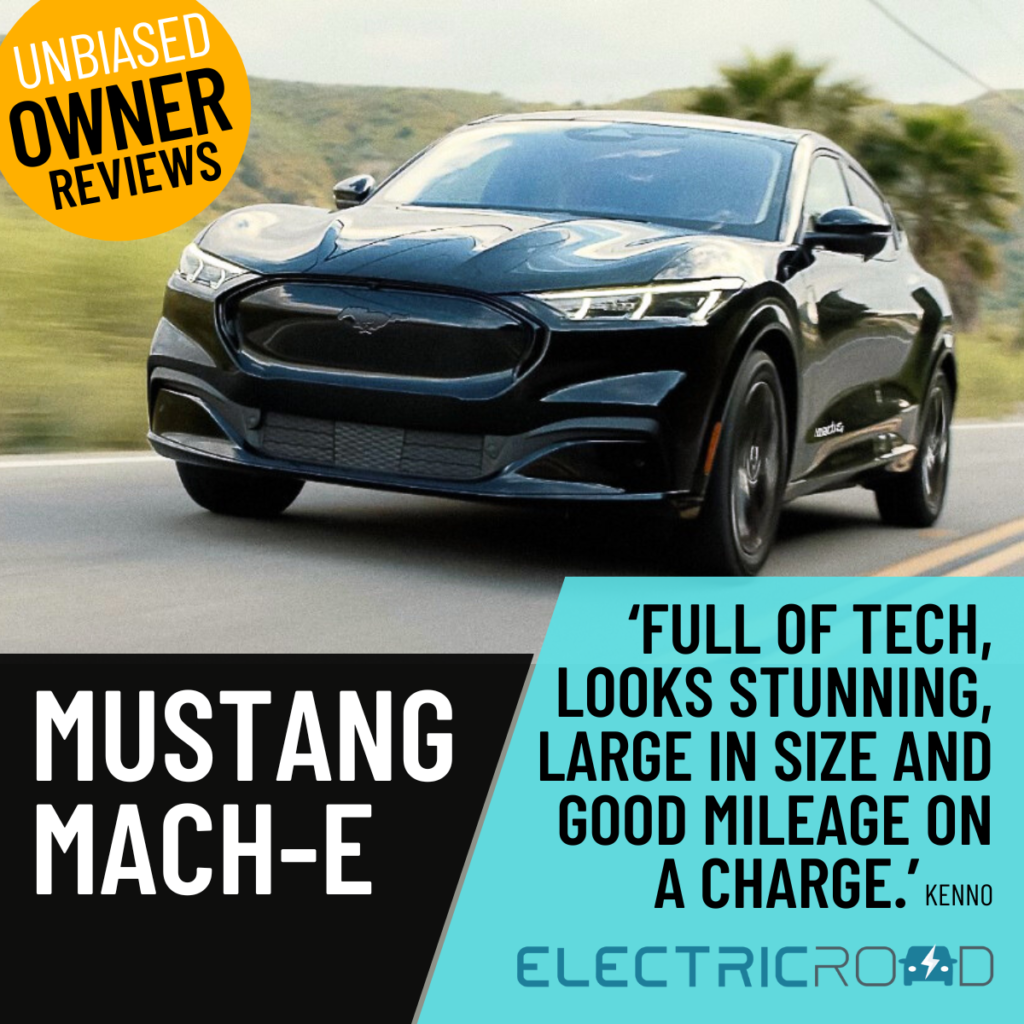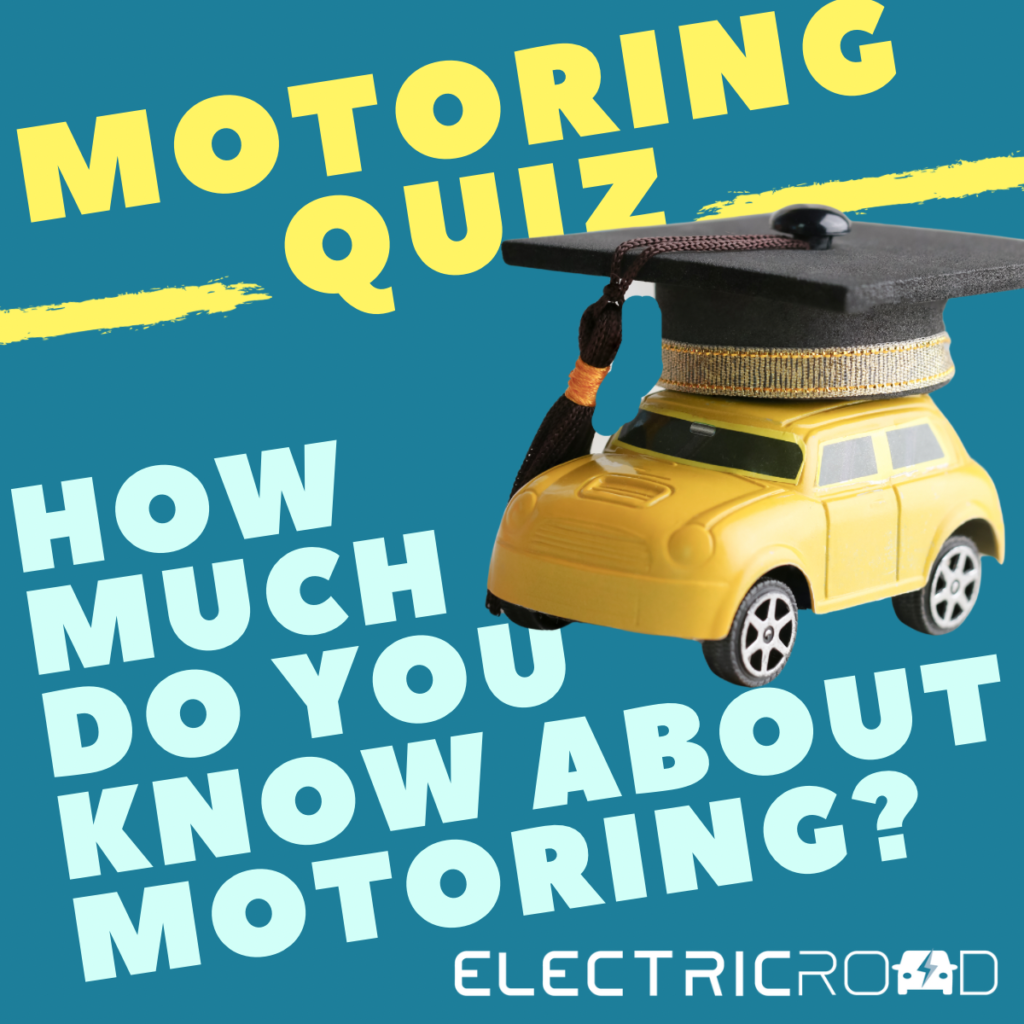The e-Niro is Kia’s second globally sold electric vehicle after the Soul EV. The new model made its European debut at the 2018 Paris Motor Show. Since 2018, more than 10,000 e-Niros have been sold in Europe.
Futuristic design inspired by 2018 Niro EV Concept
Created at Kia’s design centres in California, USA and Namyang, Korea, the e-Niro incorporates the practicality and appeal of a crossover in a sleek, aerodynamic body with subtly sculptured surfaces. The car demonstrates that, in seeking greater on-road efficiency, electric vehicle buyers need not sacrifice emotionally engaging design or crossover versatility.
Get our FREE ‘Kia e-Niro Guide’ e-mailed directly to your inbox
The Kia e-Niro differentiates itself from the existing Niro Hybrid and Niro Plug-in Hybrid with a series of design features. Taking inspiration from the Niro EV Concept unveiled at the 2018 Consumer Electronics Show in Las Vegas, the exterior is based on a ‘Clean and High-tech’ design concept. Its futuristic and aerodynamic ‘tiger-nose’ grille features an integrated charging port, bearing a de-bossed Niro logo. Redesigned air intakes and new arrowhead-shaped LED daytime running lights combine with blue trim highlights to help it stand out further.
The Kia e-Niro is available in a selection of five contemporary paint colours, one of which is unique to the e-Niro, called Yacht Blue.

Modern interior with dedicated electric powertrain technologies and crossover utility
There will be no combustion engine-only Niro. Its all-new platform has been engineered exclusively for electrified vehicles and has been designed to accommodate present and future electrical components within a compact vehicle footprint with minimal intrusion into the spacious interior and luggage area.
Inside the Kia e-Niro, the cabin combines a modern design with generous space and technologies that complement its zero-tailpipe emissions powertrain. The interior is differentiated from other Niro models with a range of new features and design elements.
The design of the centre console represents the biggest change for the e-Niro, with the all-electric powertrain not requiring a traditional gear lever and gear linkage. The physical transmission has therefore been replaced with a new ‘shift-by-wire’ rotator dial drive selector. The drive selector dial sits on its own highly ergonomic panel which extends out from the base of the central armrest.
In addition to the rotator dial, this new panel also houses buttons for the electronic parking brake, drive mode select, parking sensors, and the e-Niro’s braking ‘Auto Hold’ function. On grades ‘3’ and ‘4+’, it also incorporates the heated seats and heated steering wheel switches. The new panel requires no bulky transmission tunnel, enabling Kia’s designers to create a larger storage area at the base of the centre console.
The dashboard features bright blue trim around the air vents, echoing the trim highlights found on the outside of the car. New high-gloss black and blue trim also lines the doors of the e-Niro, further enhancing the futuristic atmosphere of the cabin. The shelf at the base of the instrument panel features a wireless charger for Qi-equipped smartphones on grades ‘3’ and ‘4+’.
On grade ‘3’ and ‘4+’ versions, the new 10.25-inch touchscreen HMI (human-machine interface) in the centre of the dashboard offers a series of features specific to Kia’s new electric vehicle. It enables owners to locate nearby charging points and monitor the level of remaining charge and range. It also lets owners gauge their trip and lifetime CO2 reduction from driving the e-Niro, compared to a petrol car of a similar size.
The HMI lets owners set an approximate departure time for their next journey, enabling the car to heat itself to a set temperature before the driver departs. The charge management function also intelligently manages the flow of electricity to the battery when charging, to help extend the life of the battery.
The 7.0-inch TFT colour instrument cluster shows driving and battery charge information on-the-move. The display also gauges the driving style of whoever is sitting at the wheel, attributing a percentage to the amount of ‘economical’ driving they manage on each journey. For drivers preferring to enjoy the car’s low centre of gravity and instant off-the-line acceleration, the display also shows what percentage of a journey has been completed with ‘dynamic’ driving.
A lamp is integrated into the top of the dashboard, with a light displaying whether the battery pack is recharging or fully charged when plugged in. This enables owners to quickly see the car’s charging status at a glance when charging.
Electronic Stability Control and Vehicle Stability Management, which collectively control skids when cornering or accelerating on surfaces with uneven levels of grip, are standard, while Hill-start Assist Control (HAC) prevents the car from rolling backwards when setting off on gradients.
The battery pack is housed underneath the floor, which allows for a larger boot compared to the parallel hybrid and PHEV versions of the Niro.
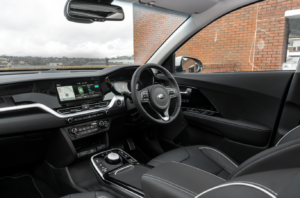
282-mile driving range from next-generation all-electric powertrain
The e-Niro offers buyers a convincing alternative to compact crossovers powered by traditional petrol or diesel internal combustion engines. It gives owners the opportunity to complete both long-distance drives and daily commutes with zero emissions and ultra-low running costs.
The e-Niro is equipped with a choice of two power outputs, both featuring a lithium-ion battery pack. The 39kWh version manages 180 miles on a single charge, producing zero on-road CO2 emissions, while on the WLTP city cycle, it can travel up to 251 miles. The 39kWh battery pack is paired with a 134bhp (100kW) electric motor that produces 395Nm of torque and allows the e-Niro to accelerate to 60mph in a pleasing 9.5 seconds.
The high-powered 64kWh edition provides a driving range of more than 282 miles on a single charge, and up to 382 miles when measured on the WLTP city cycle. The long-distance 64kWh battery pack is combined with a 201bhp (150kW) electric motor that packs 395Nm of torque and enabling it to accelerate from 0-to-60mph in just 7.5 seconds. Like the Niro Hybrid and Plug-in Hybrid variants, the e-Niro is front-wheel-drive.
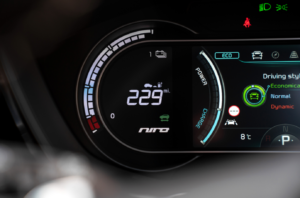
Energy-harvesting and predictive driving assistant technologies
The e-Niro provides owners with a range of technologies to enhance battery efficiency and improve the car’s range.
Regenerative braking technology allows the Niro to harvest kinetic energy and recharge the battery pack while coasting or braking, while predictive driving assistance technologies use navigation information to adjust the level of energy regeneration, depending on upcoming road conditions.
Although the electric motor requires no transmission, the car still features a pair of paddles behind the steering wheel. These paddles let drivers choose between five levels of energy regeneration: ‘Off’, ‘Level 1’, ‘Level 2’, ‘Level 3’ and ‘One Pedal’. The higher the level chosen by the driver, the more energy the regenerative brakes try to harvest, with ‘Level 1’ offering the lowest and ‘Level 3’ offering greater levels of energy regeneration.
‘One Pedal’ mode enables the maximum level of brake energy regeneration, and, in general driving, enables the driver to control the e-Niro’s speed simply by modulating the accelerator. As the driver takes their foot off the accelerator, coasting is replaced by a moderate braking effect to harness more kinetic energy – though heavier deceleration may still require braking input from the driver.
An auto regeneration mode is also available, enabling the vehicle to adjust the level of kinetic energy regeneration by itself depending on traffic conditions, using the cameras from the Smart Cruise Control system.
The instrument cluster also displays the number of miles ‘saved’ by the e-Niro’s energy harvesting systems on each trip or charge.
A battery heating system is also fitted to the e-Niro, designed to insulate and warm up the battery while the vehicle is plugged in, minimising the adverse effects of cold temperatures.
The e-Niro is also equipped with a Drive Mode Select system, enabling owners to tailor their driving experience. Switching between Eco, Eco+, Normal and Sport modes, Drive Mode Select alters the level of effort required to steer the car, and subtly changes the character of the powertrain. Eco mode maximises the potential for greater battery energy efficiency by limiting the maximum torque and power of the motor, softening throttle responses, and offering more relaxed steering inputs.
Eco+ mode adjusts the maximum vehicle speed and energy-consuming systems to achieve the highest possible energy efficiency. Normal mode is the most suitable for day-to-day driving, combining the innate efficiency and performance of the electric motor with direct steering and throttle responses. Sport mode enhances throttle responses and enables maximum acceleration, as well as weighting up the steering for more decisive responses to driver inputs, bringing the Kia e-Niro’s engaging handling character to the fore.
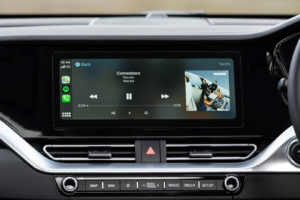
Charging times
Charging the lithium-ion polymer battery up to 80 per cent only takes 54 minutes using a 100kW direct current (DC) fast charger, no matter whether the 39kWh or 64kWh iteration is chosen. Using a 50kW DC charger, the e-Niro 39kWh charges to 80 per cent in 57 minutes, while the 64kWh version takes 75 minutes. Drivers also have the option of charging their car at a compatible regular household power socket using the ICCB-cable (in-cable control box).
The charging port is located at the front of the car, underneath a flap that is integrated into the aerodynamically-optimised ‘tiger nose’ grille. Two battery charging cables are supplied with the e-Niro; one with a standard three-pin plug allowing the car to be connected to a domestic socket and a Type 2 to Type 2 cable for connection to a public or workplace charging point.
A three-phase 11kW AC charger comes as standard on the flagship e-Niro ‘4+’. This can charge the e-Niro from 0 to 100 per cent in 7 hours.
Engine power, performance, driving range and CO2 emissions
| Model | Power bhp | Torque Nm | 0–60 secs | Max speed mph | CO2 g/km |
| ‘2’ 39 kWh lithium-ion auto | 134 | 395 | 9.5 | 96 | 0 |
| ‘3’ 64 kWh lithium-ion auto | 201 | 395 | 7.5 | 104 | 0 |
| ‘4+’ 64 kWh lithium-ion auto | 201 | 395 | 7.5 | 104 | 0 |
Warranty
Kia set a new benchmark in 2007 when it launched the Cee’d with an industry-best seven-year/100,000-mile warranty. That demonstration of faith in the quality and reliability of Kia products was subsequently extended to every model.
A major benefit is that it is transferable to subsequent owners at no charge, as long as the seven-year time limit has not been reached and the mileage is below 100,000.
The mechanical warranty is supported by a 12-year anti-perforation warranty and a five-year paint warranty.
Servicing is required every 10,000 miles or once a year, whichever comes soonest. The e-Niro is available with Kia’s ‘Kia Care’ service plans, which have been developed to provide customers with a wide range of service plan options for any Kia model within the first seven years of the vehicle’s life – matching its industry-leading seven-year warranty.
See owner reviews here


